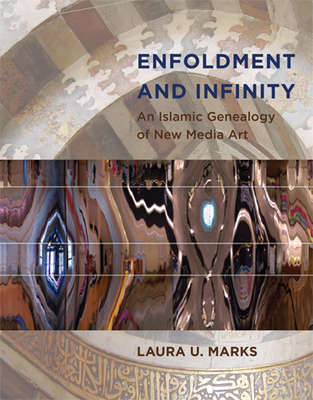
| title: | Enfoldment and Infinity: An Islamic Genealogy of New Media Art |
| year: | 2010 |
Reviewed by Rob Harley in Leonardo Reviews
“Enfoldment and Infinity is a fast paced, scholarly tour de force. Mark’s depth of understanding of Islamic culture and the various philosophies that historically have been used to produce its art – including poetry, architecture, utensil decoration, music and of course carpets – is quite profound. Perhaps more than any other religion, an understanding of the political influences involved is as important as understanding the various scriptures and their interpretations. Marks considers these factors and describes clearly how and why the various forms of Islamic art were created the way they were. She argues “that new media art, considered Western, has an important genealogy in the aesthetics, philosophy, and science of classical Islam” (p. 149).
The book has a centre, colour plate section together with numerous black & white illustrations. As Marks mentions herself, the photographs cannot do justice to the texture and relief features of carpets and the domed ceilings of mosques. There are ten chapters, followed by an extensive Notes section and an excellent Index. The chapters are as follows:
1 – Getting Things Unfolded
2 – Islamic Aesthetics and New Media Art: Points of Contact
3 – The Haptic Transfer and the Travels of the Abstract Line, Part I
4 – The Haptic Transfer and the Travels of the Abstract Line, Part II
5 – The Haptic Transfer and the Travels of the Abstract Line, Part III
6 – Baghdad, 830: Birth of the Algorithm
7 – Baghdad, 1000: Origin of the Pixel
8 – Cairo, 972: Ancestor of the Morph
9 – Herat, 1487: Early Virtual Reality
10 – Karabagh, 1700: Seeds of Artificial Life
Chapter 1 is basically an introduction and description of the approach taken in the following chapters. Chapter 2 proposes several properties that are common to Islamic art, regardless of its historical period, and contemporary abstract and new media art. Chapters 3 – 5 follow the westward travels of Islamic aesthetics, from the twelfth to twentieth centuries. Chapter 4 argues that by the nineteenth century, the subjective states that accompany Islamic art had without doubt begun to manifest in Western art and popular culture. Chapter 5 suggests that Islamic aesthetics subtly informed the aesthetics of aniconism and algorithmicity in the cybernetics of the 1950s and 1960s. This chapter ponders whether networks are the haptic space of our age. Chapter 6 proposes a historical parallel to new media in art of the Sunni world from the tenth and eleventh centuries that privileged geometric forms. Chapter 7 is mainly devoted to atomism, a brief and fascinating movement in ninth-century Iraq, which holds that the world consists of accident and fluctuation, changing at God’s command. Chapter 8 looks at calligraphy whereby letters and words start to look like bodies. While chapter 7 shows that in some contexts the point or pixel is thought to be the inner limit of thought chapter 9 examines the infinitesimal dimension – the idea that the smallest point has an inside. Chapter 10 explores that unfolding is like life itself. This chapter is devoted to another fascinating commonality between new media art and much Islamic art: qualities of nonorganic life, self-organization, or autopoesis (pp. 33 – 35)."

